Drumossie Culloden Moor was the place of the famous battle in 1746 near Inverness. This is a very emotional battle for the Scottish people, as the Clans lost their right to wear their plaid colors, play the bagpipes or publicly meet as a family group. In the Scotland Homecoming 2009, they called this conflict a civil war. Scots fought on both sides. Others consider it a religious war, and still others consider it a political battle. This page will not go into details, as many books and web sites exist on the main battle. "Culloden" by John Preeble (Penguin Books) is one of the better written documents. Some more modern and colorful books are "Culloden 1746" by Peter Harringon (Osprey Military) or "Culloden and the '45" by Jeremy Black (St. Martin's Press) show many of the maps and layout of the battle. This page will cover the MacInnes connection that is still alive today.
Appin Banner
Most of the MacInneses at Culloden were in the Appin Regiment, although a few others were in regiments as noted below. Each regiment had its own banner or colours and was always a target of the opposing side. The Appin Regiment suffered severe casualties. The Museum of Scotland in Edinburgh reports that as many as 17 different clansmen held the Appin Banner. It was ripped with grapeshot that was used against the clansmen.
According to the book, "NO QUARTER GIVEN", the muster roll of MacInneses in Prince Charles Edward Stuart's Army 1745-46 is shown below.
Editors are Alastair Livingstone of Bachuil (the father of the current Livingstone chief), Christian W.H. Aikman and Betty Stuart Hart.
MacInneses were represented by:
10 in Stewarts of Appin
MacInish, Archibald; Maryburgh
MacInish, Donald, son of ferryman; Ballachulish
MacInnes, Archibald; Argyll
MacInnes, Archibald; Stirlingshire
MacInnes, Malcolm; Sallachil, Fasnacloich Estate
MacInnis, Donald; Ballachulish Estate
MacInnis, Donald; Fasnacloich Estate
MacInnis, Ewen; Ballchulish Estate
MacInnis, John; Inverfoulla, Invernahyle Estate
MacInnis, Paul; Ballachulish Estate
1 in Gordon of Glenbucket
MacInnes, Thomas; labourer, Banff
3 in MacDonalds of Clanranach
MacInnes, Anrew; grazier, Tray, Morar
MacInnish, Duncan Maclan; Allt-an-Doran
MacInnish, Mor Ruari; Caoles
3 in MacDonalds of Glencoe
MacInnes, Donald; Brecklet
MacInnes, Donald; Kelisnacon
MacInnis, John; Inverchoan/Polveige
1 in MacDonnell of Keppoch
MacInnes, John; Achuachrach
4 in MacKinnons
MacInnes, John; chief's boatman
MacInnes, John; Glasnakille
MacInnes, John; Kilbride
MacInnes, Donald; Harrapool
Total of 22.
Donald Livingstone, 18, whose mother Anna was a MacInnes, bravely rescued the banner. Donald wrapped the banner around himself, and then put on his coat to help hide it. The British saw him and shot him. He was said to have been knocked senseless, but was not injured. He managed to grab a loose mount and went back to Morvern where he presented the Appin Banner to his mother.
Donald later gave the banner to the father of his commander, who lived in Ballachulish. The banner was later hung in Edinburgh Castle and now resides in the National Museum of Scotland in Edinburgh.
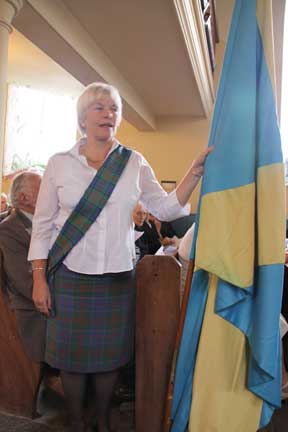
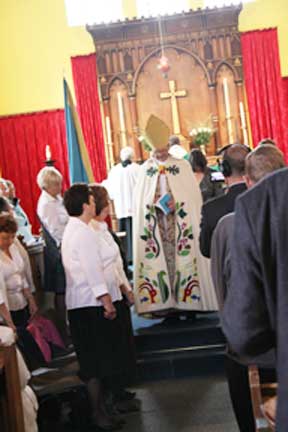
Left: Mhairi Ross (nee Livingstone) carried the replica Appin Banner into St. John's Church at Ballachulish as part of the 2009 Homecoming. Her ancestor, 18-year-old Donald Livingston (son of Anna MacInnes of Morvern), rescued the Banner and Appin Chalice from the carnage after Culloden.
Right: An honorary Gaelic service honoring Clan MacInnes July 19, 2009. Mhairi with the flag again.
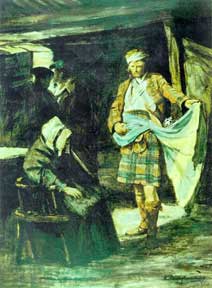
Donald Livingstone presenting the Appin Banner to his mother Anna MacInnes.
A larger version of this picture "The Return of the Appin Banner" by Sleath Cumming can be found here.
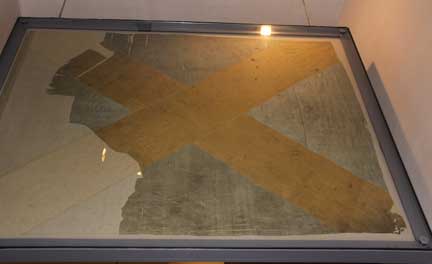
Appin Stewart Regiment - regimental colour carried at Culloden, 1746
© Trustees of the National Museums of Scotland
Click on the image to see a museum photo of the original flag.
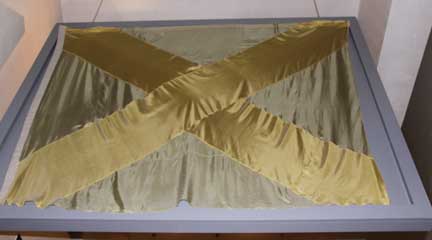
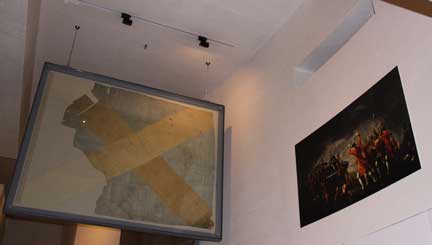
Left: A replica banner is on the opposite side of the original.
Right: Appin Flag and David Morier painting.
© Trustees of the National Museums of Scotland

© Trustees of the National Museums of Scotland
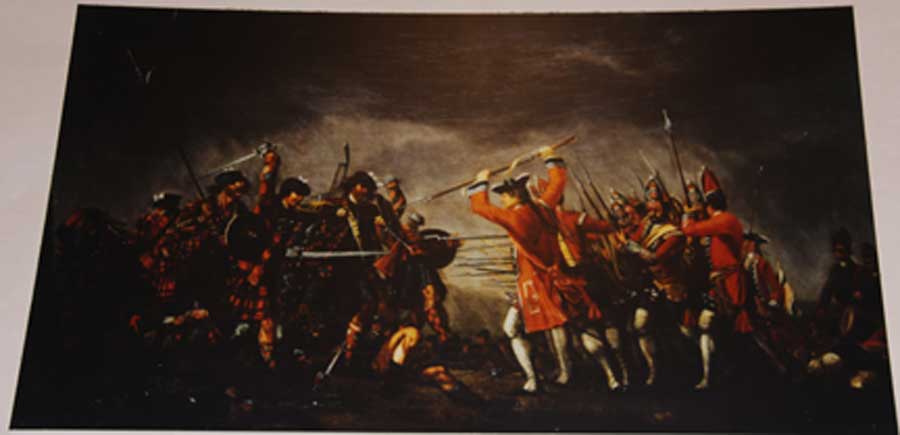
The David Morier painting, now owned by the Queen. It has been stated that several of the men captured at Culloden were used to stage this painting.
© Trustees of the National Museums of Scotland

© Trustees of the National Museums of Scotland
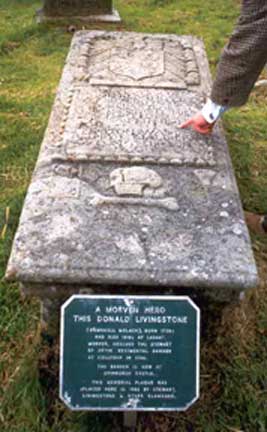
The grave of Donald Livingstone at Kiel Church in Morvern. His mother Anna is also buried at Kiel Church. The church is famous with Clan MacInnes.
The gravestone has classic Celtic symbols like the skull and bones, and shield. Here local historian Iain Thornber is pointing out the various symbolisms.
Visit the Kiel Church page for more information on the cemetery and church grounds.

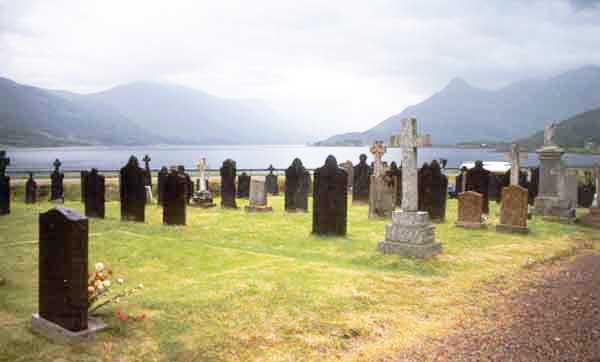
Ballachulish St. John's Church cemetery looking towards the burial isle, Eilean Munde.
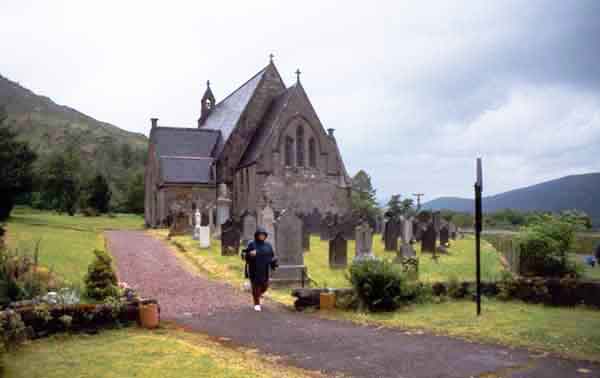
Ballachulish St. John's Church where the clansmen going into battle had communion.
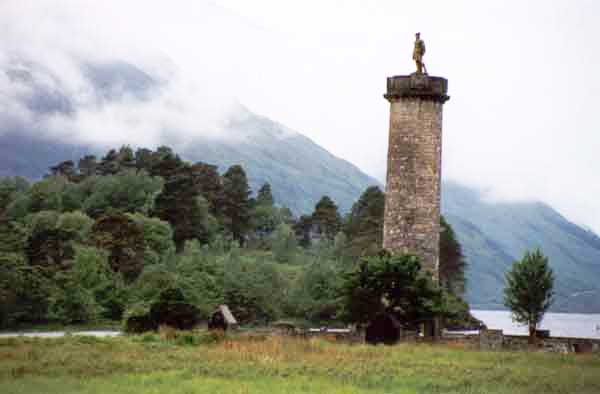
The Glennfinnan Monument where Prince Charlie met with the Clans and received their oaths. Close by is a center that details the history. To the other side of this monument is a beautiful stone viaduct where the steam train known as the "Harry Potter" train passes. The train runs daily.
Clan Livingstone web site.
A partial muster of the Appin Regiment shows the listing of the MacInneses in the battle. The abbreviation of M' is the same as Mac or Mc. The Stewarts of Appin was written by John Stewart in 1880.
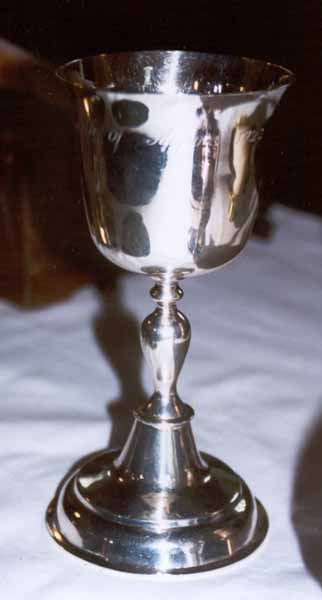
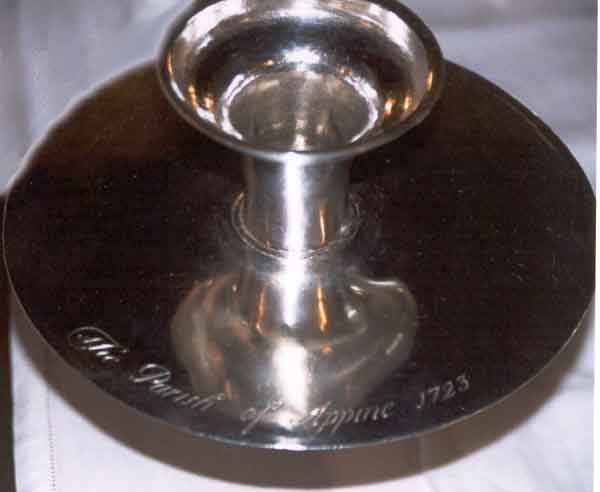
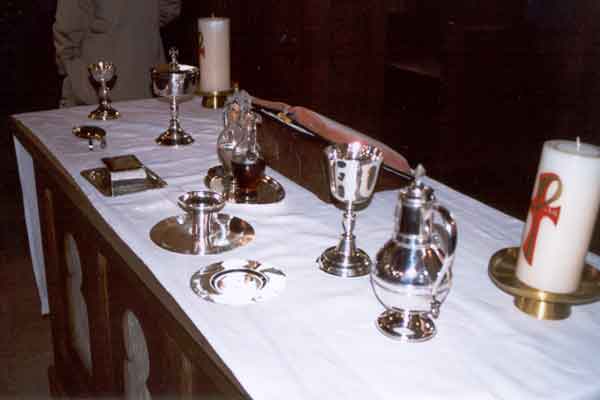
Above: Communion setting at St. John's Ballachulish. Several members of the MacInnes Tour were allowed to drink out of the chalice on a recent visit to the church.
Right: The chalice on the communion paten.
Below: Chalice close-up.
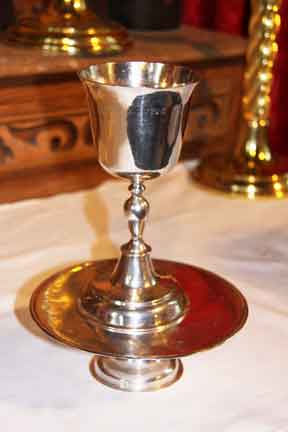
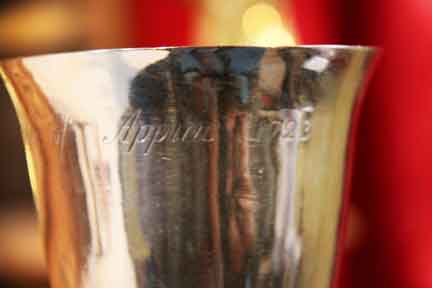
The Culloden Centre is a beautiful newly-built building on the battlefield site. The Centre is very well done, with many rooms and corridors with displays. On the left is the blue side representing the Jacobites. On the right is the red side representing the Hannover British Army. The Centre story starts with the background to the conflict through the various phases. Many artifacts are displayed. A surround theatre presents a recreation of the battle that lasts 45 minutes. After this area, the visitor can collect a headset and begin to tour the grounds. There are many marked sites, the headsets are GPS enabled to sense where you are on the site. Red and blue flags are on the field showing where the original lines where drawn.
The Centre has done a lot of work to validate the battle. Researchers went out with metal sensors and found many artifacts. These artifacts gave them a clearer idea of what had happened in the field, and changed some of the lines accordingly.
Coming back inside is a small display of the aftermath of Culloden, but this area is very small.
It is unfortunate that Clan MacInnes cannot support the Centre. There are three main problem areas, recent changes from the National Trust for Scotland, that the Association feels the way history is portrayed has been changed.
1) All the regiments were made up of volunteers from the area and most regiments had members of various clans involved. Initially Clan MacInnes with 22 members in the muster was not mentioned in the display area in the Centre as one of the clans represented. This omission was later corrected.
2) Only the Stewarts and MacLaren are now mentioned on the Appin Regiment Marker Stone on the battlefield. For many years the marker stone had merely stated "Appin Regiment". Why the amended version of the "Appin Regiment, Stewarts and MacLarens" on the new stone? All other clans have no objection to the specific listing of Stewarts as they had the largest representation in the regiment. Why have the MacLarens received specific recognition to the detriment of other clans? After all, the MacLarens had fewer recruits in the Appin Regiment and lost fewer men than, for example, the MacColls. Indeed the MacLaren Clan was chiefless from 1672 to 1957. The International Association of Clan MacInnes would prefer that the marker revert to the earlier format of "Appin Regiment". As a compromise the Association would be happy for all participating clans in the Appin Regiment to be acknowledged. A mail/email campaign with the National Trust for Scotland has to date, not been successful, and repeated attempts to set up a meeting with the Chairman of the Trust have been rejected (a copy of the appeal letter is shown here should you feel you want to add your weight to the campaign). Clan Livingstone has also been very supportive of our efforts.
3) The aftermath of the Battle of April 1746 is very much understated. The atrocities that the British government committed against the Scots is well known; women and children were killed, clansmen hunted down and killed and the injured on the field mutilated. The British Hanoverian commander Cumberlaud was nicknamed "The Butcher" because of his actions.

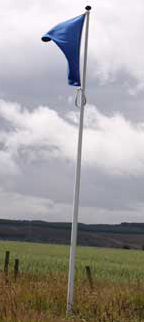
The walkway into the Centre is marked with stones of the various clans. Clan MacInnes chose not to have a marker for reasons mentioned above.
Right: The blue flags marking the start of the clan line.

The wall leading into the Centre with the clan blue and Hannover British red markers. On the left is the Gaelic of Culloden. The battlefield is behind this wall.

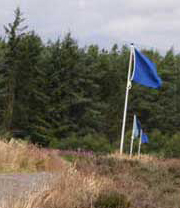
This is a map at the start of the outdoor tour. In the white is the walking tour.
To the right is the clan line flags.
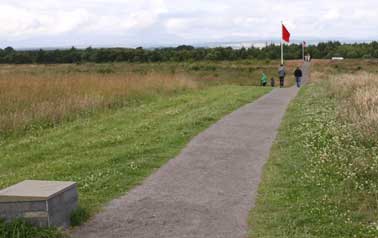
The red flags marking the Hannover British Army line. The elevation drops from here to the blue line, they had the advantage of shooting their cannons downhill.
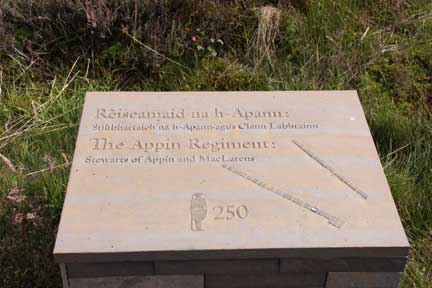 There were many other clans that fought in this regiment besides MacLaren, including Clans MacInnes, Livingstone, MacColl, Carmichael, MacCombich and Buchanan.
There were many other clans that fought in this regiment besides MacLaren, including Clans MacInnes, Livingstone, MacColl, Carmichael, MacCombich and Buchanan.This is the controversial stone marker of the Appin Regiment. 250 is the number of men.

Bagpipes from 1746 at the entrance of the museum.
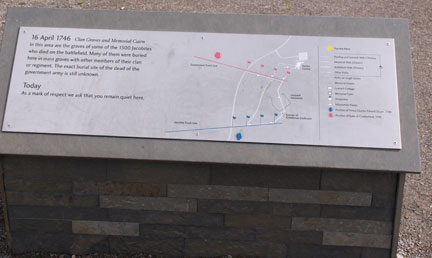
The battlefield map at the start of the outdoor tour.

This overlooks the battlefield. Although grassy today, in 1746 this field was a boggy mess, hard to walk.
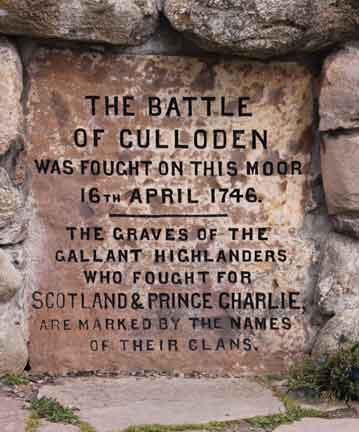
Above: This is the plaque shown in the right photograph, bottom center of the picture.
Across from this place are the other markers shown below.
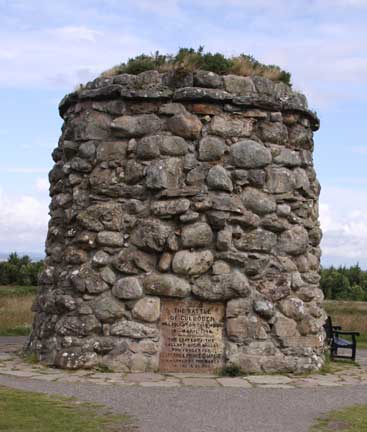
A cairn shows where many of the dead who died that day were buried.
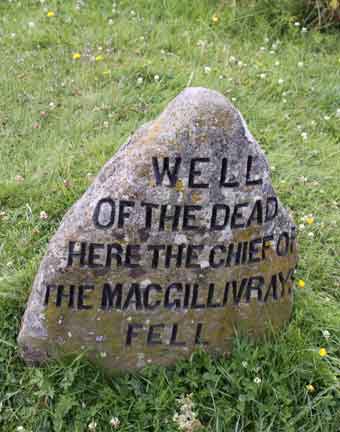 Some of the clan markers seen across from the Carne. Some have lost their markings, as shown below.
Some of the clan markers seen across from the Carne. Some have lost their markings, as shown below.
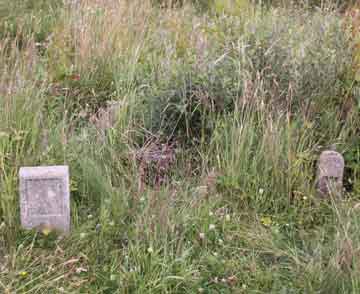
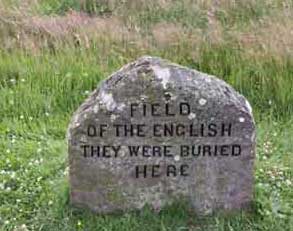
A simple marker for the British soldiers buried there. Almost all the British soldiers were Scottish as well.
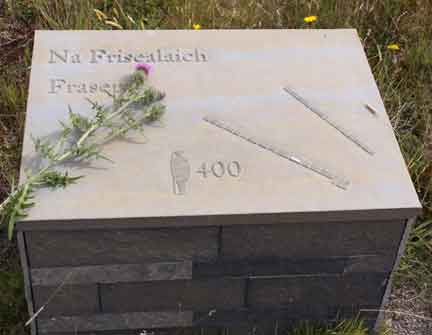
Several of the clan markers had flowers, showing the emotion that still exists. To the right is a marker that list all the clans of that regiment.
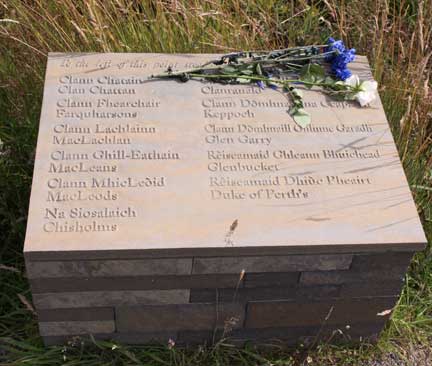
 The symbols of Scotland were abundant that day, heather in bloom alongside wild flowers and daisies. And our friend, the bee, on a thistle along the blue flag path of clans.
The symbols of Scotland were abundant that day, heather in bloom alongside wild flowers and daisies. And our friend, the bee, on a thistle along the blue flag path of clans.
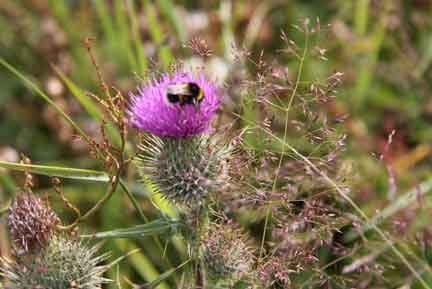
A thistle and bee at the Culloden site.
MacAonghais a-rithist!